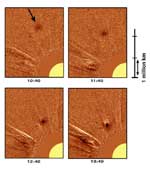Gas Heading the Wrong Way
 Click to enlarge this NASA ESA SOHO image of gas falling inward toward Sun |
The gas clouds are very close to the Sun and they actually move against the so-called solar wind, which is composed of fast-moving streams of gas pouring out continuously from the Sun.
As solar magnetism envelops Earth, it quarrels with our planet's own magnetic field, but also helps protect us from cosmic rays from other stars. Scientists suggest the inward flow of gases is due to frequent local changes in the Sun's magnetic field.
Glowing fountains on the Sun. Astronomers have known for a long time that glowing fountains and arches of hot gas rise and fall in the Sun's lower atmosphere. The newly-discovered gas clouds seem to begin their descent farther out in the Sun's atmosphere.
An inflow can start 1,700,000 miles above the Sun's visible surface. That distance is equal to twice the Sun's diameter. At that altitude, the departing accelerating solar wind reaches a speed of 75 miles per second. Flying in the face of that, the gas clouds travel inward at 31 to 62 miles per second. It seems to stop about 435,000 miles out.
LASCO. The inward flowing gas clouds have been found in images collected since 1996 by the Large Angle and Spectrometric Coronagraph (LASCO) instrument aboard SOHO. Altogether, some 8,000 inflow events have been logged. Most have been seen since 1998 during a time when the Sun has been at its most active with the highest numer of sunspots.
Rising and falling. For decades, astronomers have been able to observe gravity allow cooler gas to rise and then fall in the solar atmosphere. Until the new discovery, the hotter electrically-charged gas high in the Sun's outer atmosphere -- the corona -- has been seen flowing up and out. The question is how do the inflows relate to magnetic fields, the solar wind and violent space weather.
The LASCO instrument on board SOHO blocks intense direct light from the Sun's visible surface. That keeps the Sun permanently in eclipse so its much fainter outer atmosphere can be seen. Even with such a powerful instrument, the inflows have been hard to see. The LASCO C2 component shows the region from 435,000 to 2,175,000 miles from the visible surface.
Patchwork magnetic field. Near the Sun's surface, the magnetic field is a patchwork of field lines looping out from some places and back in at others. The solar wind drags the longest loops far out, creating contrasting sectors where the magnetic field lines are directed in opposite ways. That is, opposite polarities. However, before the solar wind reaches full speed, opposing field lines short-circuit and form new magnetic loops. These collapse towards the Sun, carrying with them the inflowing gas clouds.
SOHO's inflows thus provide clues to what influences solar magnetic activity near the Earth and all across the Solar System. Apart from magnetic storms, which can harm electronic systems on Earth, there is growing interest in the shield that the interplanetary magnetic field provides against cosmic rays. These energetic particles from the Galaxy can cause genetic mutations in living things and glitches in computers, and some scientists think they are also involved in cloud formation on the Earth. But their variations have puzzling features.
Reductions and increases in cosmic rays reaching the Earth are not in perfect step with rising and falling sunspot activity. And when sunspot cycles were of longer duration, 100 years ago, the interplanetary magnetic field was weaker and the cosmic-ray intensity was on average higher than nowadays. The 'mind-changing' discovery of the inflows near the Sun may lead to better explanations of these variations, and eventually to predictions of cosmic-ray intensities.
Solar and Heliospheric Observatory. NASA launched SOHO in December 1995. In 1998 ESA and NASA extended its operation until 2003. SOHO is a cooperative project between the European Space Agency (ESA) and NASA. The spacecraft was built in Europe for ESA and equipped with instruments by scientists in Europe and the United States.
LASCO is already famous for registering explosive mass ejections from the Sun, and discovering many sungrazing comets. A multinational scientific team that includes the U.S. Naval Research Laboratory, France's Laboratoire d'Astronomie Spatiale, Germany's Max Planck-Institut für Aeronomie, and the UK's Birmingham University, contributed LASCO to SOHO.
Learn more:
SOHO Exploring the Sun [ESA]
SOHO Exploring the Sun [NASA]
Large Angle and Spectrometric Coronagraph Experiment [LASCO]
Doubling of the interplanetary magnetic field [Ulysses]
SOHO's latest surprise - gas near the Sun heading the wrong way [Goddard]
| Sun and Sunspots Index Page | |||||
|---|---|---|---|---|---|
| Learn More about Our Sun and Sunspots and Their Effects on Earth |
| Read more Space Today Online stories about the Solar System | |||||
|---|---|---|---|---|---|
| Star: | The Sun | ||||
| Inner Planets: | Mercury | Venus | Earth | Mars | |
| Outer Planets: | Jupiter | Saturn | Uranus | Neptune | Pluto |
| Other Bodies: | Moons | Asteroids | Comets | ||
| Beyond: | Pioneers | Voyagers | |||
| Top of this page | Solar System index | Space Today Online cover |